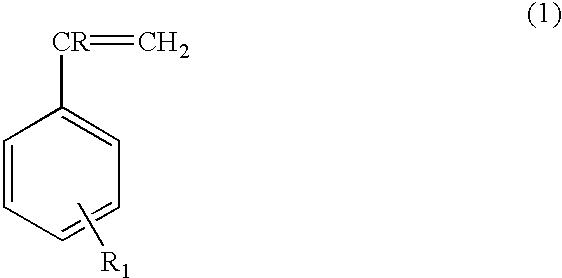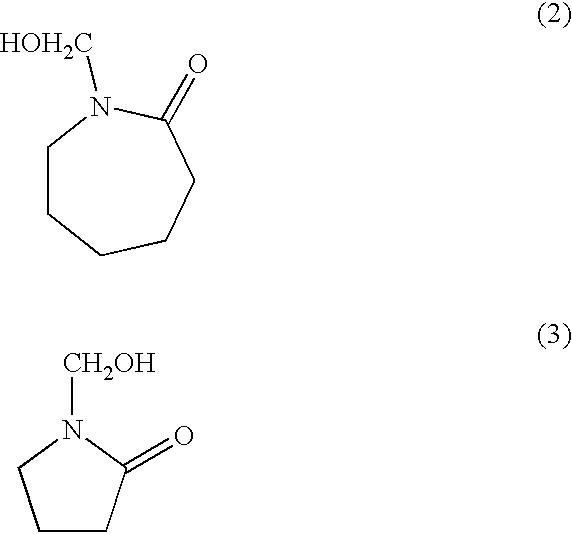Resorcinolic derivatives and methods of making and using the same
a technology of resorcinolic derivatives and derivatives, applied in the field of resorcinolic derivatives and methods of making and using the same, can solve the problems of loss of product, reduced rubber compounding properties, and uncured rubber mixtures that exhibit very low viscosity
- Summary
- Abstract
- Description
- Claims
- Application Information
AI Technical Summary
Benefits of technology
Problems solved by technology
Method used
Image
Examples
example 1
A 500-ml reaction kettle equipped with a stirrer, thermometer, reflux condenser and an addition funnel was charged with 1.0 mole (110.1 grams) of resorcinol and heated to 120-130.degree. C. P-Toluene sulfonic acid (PTSA, 1.0 gram) was then added and mixed for 5 minutes. Then 0.8 mole (83.3 grams) of styrene was added slowly over a period of about 90 minutes. The temperature of the reaction mixture was maintained between 125-135.degree. C. during the styrene addition. After all styrene was added, the reaction mixture was maintained at this temperature for an additional 60-90 minutes. Then 0.75 mole (143.3 grams of 75 weight percent aqueous solution) of N-methylol caprolactam was added slowly into the kettle over a period of 60-90 minutes at 95-120.degree. C. The reaction mixture was held at this condition for an additional period of 60-90 minutes. Finally, 0.5 gram of 50% aqueous sodium hydroxide solution was added and the resin was dehydrated under vacuum (28" Hg) at 155-160.degree....
examples 2 through 6
The procedure of Example 1 as repeated in Examples 2 through 6 varying the amounts of styrene and N-methylol caprolactam used. The softening points, free resorcinol content and number average molecular weight (Mn) of the resulting derivatives are shown in Table 1.
As can be seen from the experimental results of Table 1, low free resorcinol containing derivatives with softening points in the range of 77-100.degree. C. were synthesized. The low melting points clearly indicate that high processability can be easily achieved during compounding with these derivatives.
Penacolite.RTM. Resin B-1A is a reaction product of resorcinol and formaldehyde with a number average molecular weight (Mn) of 420, which indicates that at least 3-4 resorcinol units are joined together.
Penacolite.RTM. Resin B-20-S is a styrenated resorcinol-formaldehyde resin with Mn=450. In the synthesis of B-20-S resin, resorcinol was allowed to react with styrene first before the formaldehyde reaction. The molecular weigh...
example 7
Fuming of resorcinol, its derivatives and resins at internal-mixer temperatures above 110.degree. C. is associated with the volatile products obtained from either the unreacted resorcinol and its compounds or their decomposition products. One way to determine the volatility of a material is to run a thermogravimetric analysis (TGA). Table 2 shows TGA results of resorcinol, Penacolite Resin B-20-S and the derivatives of the present invention. Analysis was performed in a nitrogen atmosphere at 10.degree. C. / minute heating rate.
From the results of Table 2, it is clear that the derivatives of this invention produced very low volatiles at elevated temperatures when compared to resorcinol. Interestingly, in percent weight loss at 125.degree., 150.degree. and 175.degree. C., the derivatives of the present invention are close to the percent weight loss seen with the Penacolite Resin B-20-S, also a low fuming resin.
PUM
| Property | Measurement | Unit |
|---|---|---|
| temperature | aaaaa | aaaaa |
| temperature | aaaaa | aaaaa |
| temperature | aaaaa | aaaaa |
Abstract
Description
Claims
Application Information
 Login to View More
Login to View More - R&D
- Intellectual Property
- Life Sciences
- Materials
- Tech Scout
- Unparalleled Data Quality
- Higher Quality Content
- 60% Fewer Hallucinations
Browse by: Latest US Patents, China's latest patents, Technical Efficacy Thesaurus, Application Domain, Technology Topic, Popular Technical Reports.
© 2025 PatSnap. All rights reserved.Legal|Privacy policy|Modern Slavery Act Transparency Statement|Sitemap|About US| Contact US: help@patsnap.com



